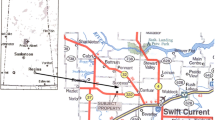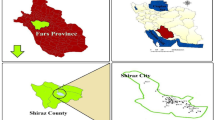Abstract
Quantifying human cancer risk arising from exposure to contaminated groundwater is complicated by the many hydrogeological, environmental, and toxicological uncertainties involved. In this study, we used Monte Carlo simulation to estimate cancer risk associated with tetrachloroethene (PCE) dissolved in groundwater by linking three separate models for: (1) reactive contaminant transport; (2) human exposure pathways; and (3) the PCE cancer potency factor. The hydrogeologic model incorporates an analytical solution for a one-dimensional advective–dispersive–reactive transport equation to determine the PCE concentration in a water supply well located at a fixed distance from a continuous source. The pathway model incorporates PCE exposure through ingestion, inhalation, and dermal contact. The toxicological model combines epidemiological data from eight rodent bioassays of PCE exposure in the form of a composite cumulative distribution frequency curve for the human PCE cancer potency factor. We assessed the relative importance of individual model variables through their correlation with expected cancer risk calculated in an ensemble of Monte Carlo simulations with 20,000 trials. For the scenarios evaluated, three factors were most highly correlated with cancer risk: (1) the microbiological decay constant for PCE in groundwater, (2) the linear groundwater pore velocity, and (3) the cancer potency factor. We then extended our analysis beyond conventional expected value risk assessment using the partitioned multiobjective risk method (PMRM) to generate expected-value functions conditional to a 1 in 100,000 increased cancer risk threshold. This approach accounts for low probability/high impact outcomes separately from the conventional unconditional expected values. Thus, information on potential worst-case outcomes can be quantified for decision makers. Using PMRM, we evaluated the cost-benefit relationship of implementing several postulated risk management alternatives intended to mitigate the expected and conditional cancer risk. Our results emphasize the importance of hydrogeologic models in risk assessment, but also illustrate the importance of integrating environmental and toxicological uncertainty. When coupled with the PMRM, models integrating uncertainty in transport, exposure, and potency constitute an effective risk assessment tool for use within a risk-based corrective action (RBCA) framework.








Similar content being viewed by others
References
Anderson EL (1983) Quantitative approaches in use to assess cancer risk. Risk Anal 3(4):277–295. doi:10.1111/j.1539-6924.1983.tb01396.x
Asbeck E, Haimes YY (1984) The partitioned multiobjective risk method (PMRM). Large Scale Syst 6(1):13–38
ASTM (1995) Standard guide for risk-based corrective action applied at petroleum release sites. American Society for Testing and Materials, E1739–95e1
ASTM (2004) Standard guide for risk-based corrective action. ASTM International, E2081–00(2004)e1
Bier VM, Haimes YY, Lambert JH, Matalas NC, Zimmerman R (1999) A survey of approaches for assessing and managing the risk of extremes. Risk Anal 19(1):83–94. doi:10.1111/j.1539-6924.1999.tb00391.x
Bogen KT, Spear RC (1987) Integrating uncertainty and interindividual variability in environmental risk assessment. Risk Anal 7(4):427–436. doi:10.1111/j.1539-6924.1987.tb00480.x
Burmaster DE, Anderson PD (1994) Principles of good practice for the use of Monte Carlo techniques in human health and ecological risk assessments. Risk Anal 14(4):477–481. doi:10.1111/j.1539-6924.1994.tb00265.x
Decisioneering (2006) Crystal Ball. Decisioneering, Denver
Haimes YY, Lambert JH, Li D (1992) Risk of extreme events in a multiobjective framework. Water Resour Bull 28(1):201–209
Kangus M (1996) Probabilistic risk assessment. ASTM Standard News 24(6):28–33
Law AM, Kelton WD (2000) Simulation modeling & analysis, 3rd edn. McGraw-Hill, New York
Lemke LD, Abriola LM (2006) Modeling dense nonaqueous phase liquid mass removal in nonuniform formations: Linking source zone architecture and system response. Geosphere 2(2):74–82. doi:10.1130/GES00025.1
Lemke LD, Abriola LM, Lang JR (2004) Influence of hydraulic property correlation on predicted DNAPL source zone architecture, mass recovery and contaminant flux. Water Resour Res 40(12):W12417. doi:10.1029/2004WR003061
Maxewll RM, Kastenberg WE (1999) Stochastic environmental risk analysis: an integrated methodology for predicting cancer risk from contaminated groundwater. Stochastic Environ Res Risk Assess (SERRA) 13(1-2):27–47. doi:10.1007/s004770050030
McDade JM, McGuire TM, Newell CJ (2005) Analysis of DNAPL source-depletion costs at 36 field sites. Remediat J 15(2):9–18
McGuire TM, McDade JM, Newell CJ (2006) Performance of DNAPL source depletion technologies at 59 chlorinated solvent-impacted sites. Ground Water Monit Remediat 26(1):73–84. doi:10.1111/j.1745-6592.2006.00054.x
McKone TE, Bogen KT (1991) Predicting the uncertainties in risk assessment. Environ Sci Technol 25(10):1674–1681
McKone TE, Bogen KT (1992) Uncertainties in health-risk assessment: An integrated case study based on tetrachloroethylene in California groundwater. Regulat Toxicol Pharmacol 15(1):86–103
Mercer JW, Cohen RM (1990) A review of immiscible fluids in the subsurface: properties, models, characterization, and remediation. J Contamin Hydrol 6(2):107–163
Mitsiopoulos J, Haimes YY (1989) Generalized quantification of risk associated with extreme events. Risk Anal 9(2):243–254. doi:10.1111/j.1539-6924.1989.tb01244.x
Oberg T, Bergback B (2005) A review of probabilistic risk assessment of contaminated land. J Soils Sediments 5(4):213–224. doi:10.1065/jss2005.08.143
Ramsburg CA, Pennell KD (2001) Experimental and economic assessment of two surfactant formulations for source zone remediation at a former dry cleaning facility. Ground Water Monit Remediat 21(4):68–82
Romei SF, Haimes YY, Li D (1992) Exact determination and sensitivity analysis of a risk measure of extreme events. Inform Decision Technol 18:265–282
Semprini L (1997) Chapter 26, In situ transformation of halogenated aliphatic compounds under anaerobic conditions. In: Ward CH, Cherry JA, Scalf MR (eds) Subsurface restoration. Ann Arbor, Chelsea, pp 429–450
Suarez MP, Rifai HS (1999) Biodegradation rates for fuel hydrocarbons and chlorinated solvents in groundwater. Bioremediat J 3(4):337–362. doi:10.1080/10889869991219443
Thompson KM, Burmaster DE, Crouch EAC (1992) Monte Carlo techniques for quantitative uncertainty analysis in public health risk assessments. Risk Anal 12(1):53–63. doi:10.1111/j.1539-6924.1992.tb01307.x
USEPA (1997) Guiding principles for Monte Carlo analysis. US Environmental Protection Agency, EPA/630/R-97/001
USEPA (1989) Risk assessment guidance for superfund, vol I—Human health evaluation manual (Part A). US Environmental Protection Agency, EPA/540/1-89/002
van Genuchten MT, Alves WJ (1982) Analytical solutions of the one-dimensional convective-dispersive solute transport equation. US Department of Agriculture, Technical Bulletin No. 1661
Varela JR (2003) Simulación 4.0. Universidad del CEMA, Buenos Aires
Vogel TM, Criddle CS, McCarty PL (1987) Transformation of halogenated aliphatic compounds. Environ Sci Technol 21(8):722–736
Washburn ST, Edelmann KG (1999) Development of risk-based remediation strategies. Practice Periodical Hazard Toxic Radioactive Waste Manage 3(2):77–82
Weber WJ, DiGiano FA (1996) Process dynamics in environmental systems. Wiley, New York
Wilson JL, Conrad SH, Mason WR, Peplinski W, Hagan E (1990) Laboratory investigations of residual liquid organics from spills, leaks and disposal of hazardous wastes in groundwater. US Environmental Protection Agency, EPA/600/6-90/004
Xu M, Eckstein Y (1995) Use of weighted least-squares method in evaluation of the relationship between dispersivity and field scale. Ground Water 33(6):905–908
Zheng C, Bennett GD (1995) Applied contaminant transport modeling. Van Nostrand Reinhold, New York
Author information
Authors and Affiliations
Corresponding author
Rights and permissions
About this article
Cite this article
Lemke, L.D., Bahrou, A.S. Partitioned multiobjective risk modeling of carcinogenic compounds in groundwater. Stoch Environ Res Risk Assess 23, 27–39 (2009). https://doi.org/10.1007/s00477-007-0192-4
Published:
Issue Date:
DOI: https://doi.org/10.1007/s00477-007-0192-4




